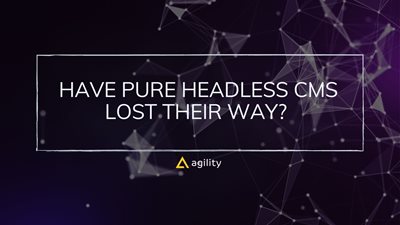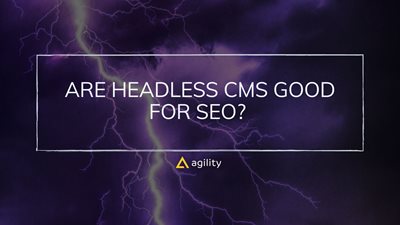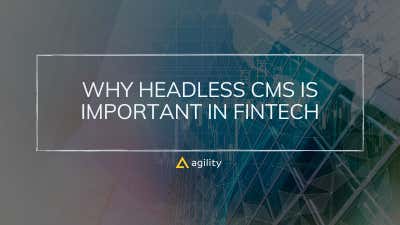Have Pure Headless CMSs Lost Their Way?
The pure headless CMS was a genius idea when it was first created but now that may not be the case as they’ve lost their way.


Developers had a great idea when new customer experience channels (think Amazon Echo and digital signage) started to emerge.
"Let's build a content management system that doesn't care about which front-end you use. It pulls and pushes content to any channel or device!"
It was genius. Suddenly, brands could create content, and design images to be spoken aloud by Amazon Alexa or displayed proudly on a wide-screen monitor at physical locations.
The only problem was that those headless CMS solutions focused purely on using APIs to push and pull content to external applications and channels—ignoring the needs of marketers and content authors. You know, the ones writing and designing the content.
What started as a stroke of genius has lost its way since.
Being Content-first is Vital- Don't Forget Content Marketers.
Headless CMSs come in different forms. Some label themselves as API-first, some as content-first, and many other variations of the headless trend. However, there is a problem with the way headless CMSs operate.
Most of them can handle content storage and distribution, making headless attractive. These platforms recognize that pushing content to various channels outside of standard websites is necessary. The ability to connect to APIs and distribute to any front end makes this possible. However, headless CMSs don't cater to the ones producing this content—the editors and marketers.
The ability to deliver content across multiple channels, like smart speakers and smartwatches in the age of IoT, is a pivotal part of the equation for content management. But you can't forget the needs of content marketers. The marketing teams need robust tools they can rely on and marketer-friendly features that allow them to evolve with the growing number of content channels and grow their websites.
Despite the need for omnichannel presence, a website remains one of the vital pieces of the digital experience. Websites no longer have to be simple one-dimensional sheets. Instead, you can create a dynamic website experience as well. Marketers need access to a CMS platform to manage and share content across multiple websites from a single instance. They also need the ability to publish rich media content, images and more to create the best content experience for their customers.
Most current CMS platforms make it easy for marketers to create and edit essential content quickly. But when it comes time to make this content more visually appealing and exciting for the customers, it can't be done without the help of a developer. Marketers lack the autonomy to create these customer experiences as CMS headless platforms forget a few things.
What (Some) Headless CMS Are Forgetting
The backbone of any great headless CMS is impressive architecture. Headless CMSs can provide significant benefits for a website today, including faster loading speed, improved customer experiences and a plethora of API options so that you don't run into a bottleneck.
A robust headless CMS needs to do the above without forgetting the tools catered towards less technical users and required to update website content like resize images, drag-and-drop features and more. Marketers are used to WYSIWYG editors, which are common in legacy CMS platforms and other frequently used marketing tools. They need autonomy and marketer-friendly features that reduce the reliance on IT departments.
Storing and managing content using a CMS makes it easier for marketers to manage content workflows and make improvements. Marketers need the ability to set up optimized workflows for approving and publishing content. They also need to view content interfaces easily and preview content across multiple channels. Many headless CMS platforms forget this feature, meaning that marketers must wait for IT departments to connect APIs and tell them if the content is displaying correctly, leading to longer implementation times.
A headless CMS acts primarily as a content repository, storing content on multiple channels. This isn't enough for the modern-day marketer and limits the organization's capabilities.
Get on Track with Agility CMS
A pure headless CMS may not be the way forward, but a content-first CMS like Agility CMS can help your marketing and IT teams get on track with marketer-friendly features. Agility CMS provides built-in SEO features, content previewing, revision history and the ability to schedule content. These content authoring tools are necessary for marketers to create and edit easily.
Features like this are perfect for marketing teams, giving them a highly customizable experience and making it easy without relying on the IT department.
Agility CMS also provides additional functionality that allows it to stand out compared to others in the headless CMS world and makes it easier for content editors to get things done independently.
Layouts
Editors can manage pages and navigation right out the box. They can create and manage pages for an app or website using reusable building blocks. Layouts provide editor-friendly options such as unlimited page templates, modules and page scheduling. Also, the ability to build dynamic pages based on a shared content list and manage multiple sitemaps using digital channels. Moreover, developers don't need to worry about editors overextending themselves and accidentally breaking something as they have complete control of the modules available to editors.
Agility CMS allows you to define three things that make working with layouts accessible for both content editors and developers to work with. Developers set up the templates and definitions, while content editors determine how and where they want to use those templates and definitions. This part of the content architecture is fundamental to the success of any CMS solution that includes a website.
Content Relationships
Agility CMS provides flexible content structures for all digital channels. Editors can import and export content, schedule content, create relationships and hierarchies and edit everything using a rich text editor.
Pure headless CMSs may no longer be the perfect solution for delivering content across multiple channels. While they provide adequate content repositories and excellent customer experiences, they lack the user experience needed for non-technical content creators. The solution is a decoupled CMS platform like Agility CMS.

About the Author
Joel is CTO at Agility. His first job, though, is as a father to 2 amazing humans.
Joining Agility in 2005, he has over 20 years of experience in software development and product management. He embraced cloud technology as a groundbreaking concept over a decade ago, and he continues to help customers adopt new technology with hybrid frameworks and the Jamstack. He holds a degree from The University of Guelph in English and Computer Science. He's led Agility CMS to many awards and accolades during his tenure such as being named the Best Cloud CMS by CMS Critic, as a leader on G2.com for Headless CMS, and a leader in Customer Experience on Gartner Peer Insights.
As CTO, Joel oversees the Product team, as well as working closely with the Growth and Customer Success teams. When he's not kicking butt with Agility, Joel coaches high-school football and directs musical theatre. Learn more about Joel HERE.

Is Headless CMS Good for SEO (Updated for 2025)

How to Persuade the C-Suite on Headless CMS

Headless CMS for the Financial Industry
Try Agility CMS, Free
We know you just want to build cool stuff. That’s why we designed Agility to give you all of the flexibility and features you need to turn your vision into reality. Whether it’s developing with today’s latest web technologies (or tomorrow’s), Agility makes it easy to stay on the cutting edge.
Get Started